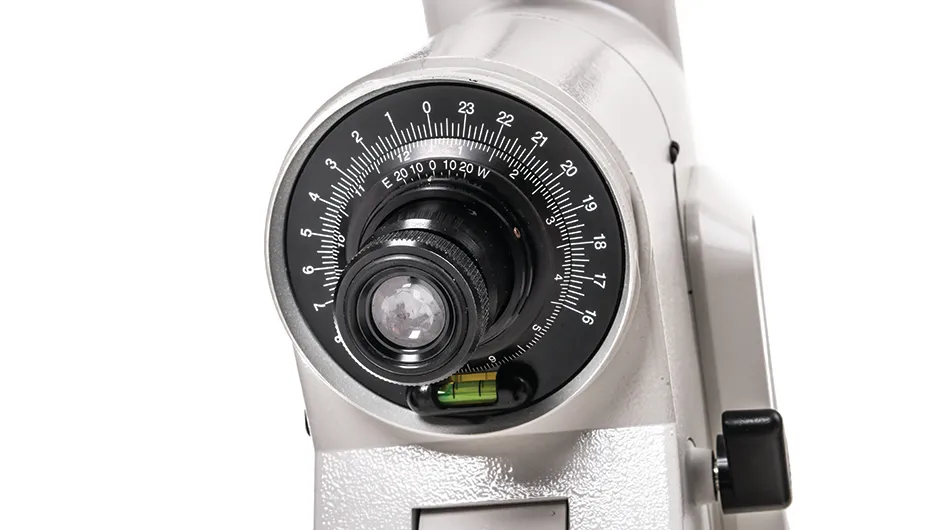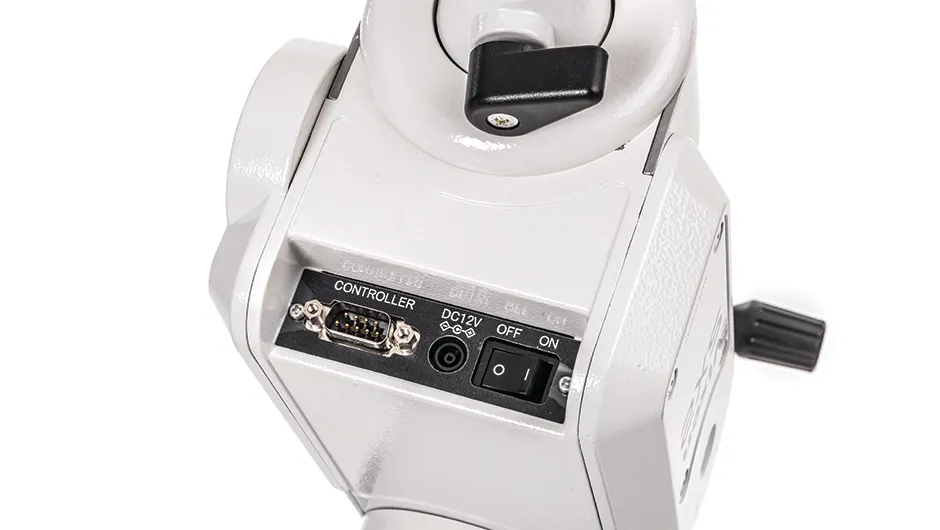Price: £2447.00
Weight: 7kg (mount only)
Supplier: Opticron/Vixen UK
Telephone: 01582 726522
Website: www.vixenoptics.co.uk
The SX2 equatorial mount is the latest basic model of the Vixen Sphinx series, suitable for small to medium sized telescopes up to 12kg.
It is supplied with one 1.9kg counterweight, a polarscope and the Star Book TEN hand controller with Advance Unit for £2,447; an alternative package (not reviewed) without the polarscope and with the Star Book ONE controller is available for £1,449.
The SX2 mount is beautifully engineered, much as we’ve come to expect from Vixen.
It is designed so that the RA body also acts as a counterweight with the cabling and electronics tucked away inside it, a nice feature that cuts down on the number of counterweights you need to balance your chosen telescope.
Mounting the SX2 on a tripod was straightforward, and on the underside of the RA body are the ports for attaching the hand controller via a serial cable, power socket for the supplied cigarette power lead and an on-off switch.
The top of the dec. axis head has a Vixen-style dovetail mounting block with a large retaining bolt, and a smaller bolt for safety when installing your telescope.
For our tests we used a Sky-Watcher Equinox 80ED refractor for wide-field views and a Sky-Watcher SkyMax 180 Pro Maksutov for higher magnification views as they both have Vixen-style dovetail bars.
Adjustment for latitude has a range of 0-70º and rough alignment has three main settings: high, medium and low.
These have a range of 15º and for our latitude of 53ºN we had to set it to the high range.
To achieve polar alignment we used both the large altitude knob to fine tune the latitude using the engraved scale, and the polarscope. Azimuth adjustment was straightforward, achieved via the front two knobs.
We were impressed with the polarscope as, unlike most other designs, you don’t have to rotate the whole mount in RA; instead you set the time and date on the polarscope scale then adjust Polaris to the marked position in the illuminated view.

Testing the tracking
Once aligned we powered up the system and, using the easily readable display of the Star Book TEN controller, we set the scope at the home position looking due west.
On the controller there are the usual basic settings for your latitude and location, and once set these are retained thanks to the in-built battery.
We were able to select up to 20 stars for alignment, giving great accuracy.
For our tests we chose planetary targets such as Jupiter and the Moon, as well as deep-sky targets from Messier, NGC, IC and SAO star catalogues over a large area of the sky.
The Go-To results were impressive: in our 26mm eyepiece using the Equinox 80ED, all of our chosen targets were placed in the central 15 per cent of the view; on most occasions they were virtually centred.
The Star Book TEN controller has a 5-inch LED back-lit display with 0.3 megapixel (800x480 pixels) format resolution.
It is menu driven, with clear, well defined subjects.
This fully featured planetarium has two chart modes, Scope and Chart.
Scope points the mount directly with the control buttons to any place in the sky, while Chart enables you to explore the sky chart and choose a target.
In the end we had so much fun exploring what the Scope and Chart modes could achieve that several hours elapsed in no time at all.
The Star Book TEN came with the new Advance Unit installed and it really enhances the controller and mount capabilities so much so that we were reluctant to part with it.

High-Powered Advances
The Star Book TEN controller is enhanced by the addition of the Advance Unit, which adds even more options via the Expansion Function menu.
The unit has two 3.5mm jack ports, one for video in and one to control a DSLR camera.
With a suitable cable you can attach a CCD camera, such as Vixen’s C0014-3M.
When activated in the menu, this enable you to use the Star Book TEN as a guiding system controlling the mount and with live on-screen views of the guide star.
It also allows full screen live views of bright objects such as planets and even the brighter deep-sky objects such as M3.
The Advance Unit also has a slot for an SD card, which enables you to record the views captured for later processing.
The 3.5mm jack for a camera allows you to programme the length of exposure, the interval between exposures, the number of exposures to be taken and a mirror lock function.
The inclusion of a USB port provides for the possibility of further expansion with future unspecified equipment.

Mount ports
The ports on the mount appear to be limited, but all you need is here.
There is a port for the Star Book TEN hand controller (a D-SUB 9-pin male plug) and a DC 12V power supply connector.
An on-off switch completes the line up.
Mount body
The electronics and cabling are inside the RA housing body, which enables it to act both as a built-in counterweight and tidies up the clutter of cables that can sprout from Go-To mounts.
This means that many small and lightweight scopes may not even require a counterweight.
Altitude and azimuth adjustment
The adjustment knobs for both azimuth and altitude were nice and chunky to grip and gave fine control over the adjustments.
The altitude adjustment can be set from 0-70º and has three main zones, with a 15º range of adjustment per zone, as well as an engraved scale.
Polarscope
Achieving accurate polar alignment is vital for ensuring accurate Go-Tos and good tracking during long exposure astrophotography.
The polarscope has a bubble level, and dates and times engraved on it.
This means that you just need to set the date and time to your night’s viewing and then move Polaris to the required spot for polar alignment.
Star Book ONE
The mount is also available with a less feature-rich controller, the Star Book ONE, which has a 22,725 object Go-To database, plus tracking and slewing control.
Star book TEN
The Star Book TEN hand controller has a full-colour LCD screen (800x480 pixels) with a huge range of menus and functions to control the mount.
It has two operational modes, an ST-4 compatible autoguider port, serial port to connect it to the mount and an expansion bay incorporating the Advance Unit.
This review originally appeared in the May 2015 issue of BBC Sky at Night Magazine.
